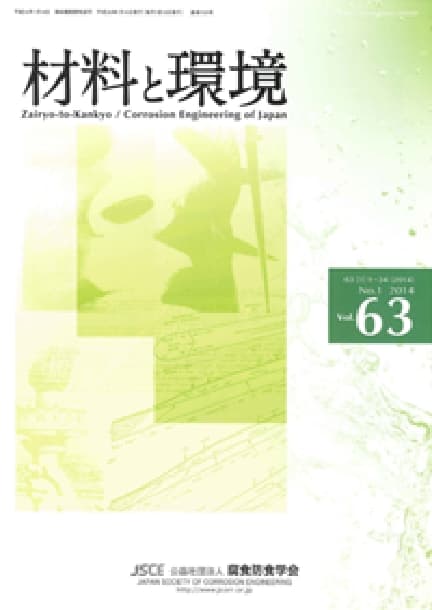材料と環境 Vol. 61 (2012), No. 5
Backnumber
-
Vol. 74 (2025)
-
Vol. 73 (2024)
-
Vol. 72 (2023)
-
Vol. 71 (2022)
-
Vol. 70 (2021)
-
Vol. 69 (2020)
-
Vol. 68 (2019)
-
Vol. 67 (2018)
-
Vol. 66 (2017)
-
Vol. 65 (2016)
-
Vol. 64 (2015)
-
Vol. 63 (2014)
-
Vol. 62 (2013)
-
Vol. 61 (2012)
-
Vol. 60 (2011)
-
Vol. 59 (2010)
-
Vol. 58 (2009)
-
Vol. 57 (2008)
-
Vol. 56 (2007)
-
Vol. 55 (2006)
-
Vol. 54 (2005)
-
Vol. 53 (2004)
-
Vol. 52 (2003)
-
Vol. 51 (2002)
-
Vol. 50 (2001)
-
Vol. 49 (2000)
-
Vol. 48 (1999)
-
Vol. 47 (1998)
-
Vol. 46 (1997)
-
Vol. 45 (1996)
-
Vol. 44 (1995)
-
Vol. 43 (1994)
-
Vol. 42 (1993)
-
Vol. 41 (1992)
-
Vol. 40 (1991)
キーワードランキング
17 Dec. (Last 30 Days)
材料と環境 Vol. 61 (2012), No. 5
SUS316Lステンレス鋼の孔食電位および孔食成長挙動に及ぼす金属イオンの影響
礒本 良則, 松尾 慎也
pp. 213-218
DOI:
10.3323/jcorr.61.213抄録
A potentiostatic method was used to measure pitting potential for SUS316L stainless steel and compared with a potentiodynamic polarization method standardized by JIS G 0577. Test conditions were sodium chloride solutions from 0.008 to 1 M containing metal ions less than 110 ppm at temperatures of 300 and 323 K. The pitting potentials of SUS316L steel decreased with the increases in concentration of chloride ions and in temperature. The test results of pitting potential were consistent between the potentiostatic and potentiodynamic polarization methods. The presence of metal ions in a 0.08 M sodium chloride solution greatly decreased the pitting potential of SUS316L steel. Pits were grown from a steel surface by using a galvanostatic method proposed in this study, and observed in a cross-sectional surface after the growth tests. As a results, it is found that the low current density or metal irons of Mn2+ and Cr3+ added in the sodium chloride solution changed the aspect ratio of cross-sectional pit morphology and promoted deeper pit growth. Mechanisms of pit initiation and growth were discussed in this study.
オーステナイト系ステンレス鋼板の切断端面における発銹挙動
斎田 知明, 山本 拓也, 佐藤 克明, 中村 繁, 興戸 正純
pp. 219-226
DOI:
10.3323/jcorr.61.219抄録
The cut edge surface of the stainless steel sheet is susceptible to corrosion compared with the surface of the sheet. At the cut edge surface, red rust easily tends to occur by the attack of chloride ion. However, there are still a lot of points not clear about the cause of the cut edge corrosion.
The salt spray test and the immersion test using NaCl solutions were conducted to evaluate corrosion resistance for the shear cut edge of SUS304 (18Cr-8Ni) and SUSXM7 (18Cr-9Ni-3Cu) cold rolled strips. It was found that transverse section (T section) corroded easier than longitudinal section (L section). In addition, the rust at the machined edge was less than shear cut edge.
The difference of the corrosion behavior in each section, L and T, was investigated by the electrochemical method. In anodic polarization curves at T section, the current density rose gradually at the less-noble potential than the L section. By the SEM observation and EPMA elemental mappings after anodic polarization measurement, it was considered that non-metallic inclusions (MnS etc.) extended along the metal flow of rolling direction influenced on the initiation and the growth of pitting corrosion.
論文アクセスランキング
17 Dec. (Last 30 Days)
-
大気腐食環境下における1700 MPa級調質ボルトの遅れ破壊機構
鉄と鋼 早期公開
-
Perspectives on the Promising Pathways to Zero Carbon Emissions in the Steel Industry toward 2050
ISIJ International Vol.65(2025), No.2
-
-
Factors Influencing the Bonding Phase Structure of Iron Ore Sinters
ISIJ International Vol.43(2003), No.9
-
-
-
Metallurgical Aspects on Interstitial Free Sheet Steel From Industrial Viewpoints
ISIJ International Vol.34(1994), No.1
-
Microstructures and Reduction Properties of High CaO Concentration Sintered Ore
ISIJ International 早期公開
-
Influence of Antimony on the Oxidation Characteristics of 65Mn Steel
ISIJ International 早期公開
-
この機能はログイン後に利用できます。
下のボタンをクリックしてください。










